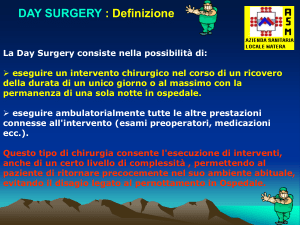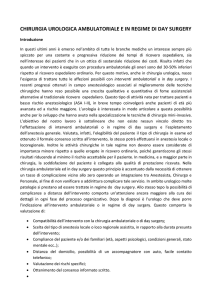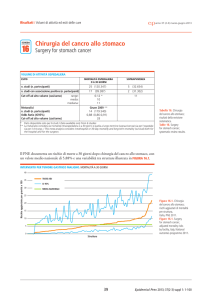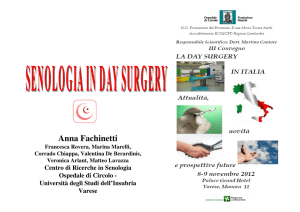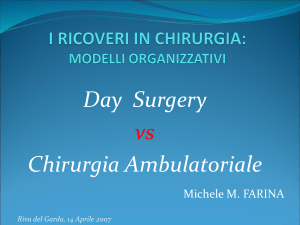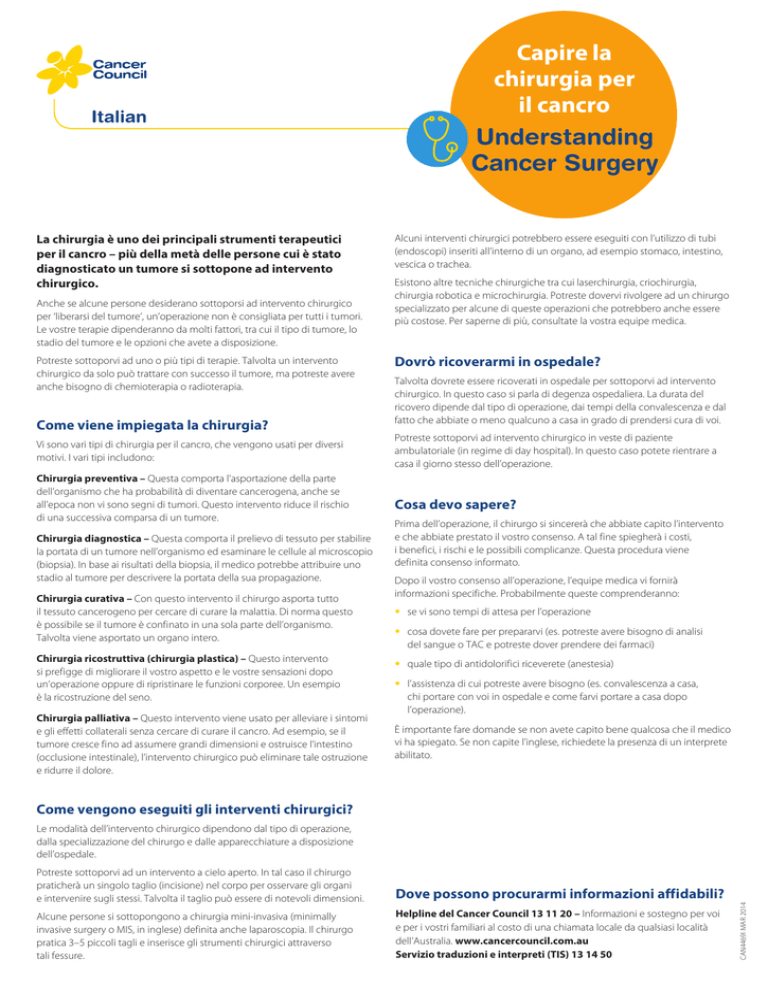
Italian
La chirurgia è uno dei principali strumenti terapeutici
per il cancro – più della metà delle persone cui è stato
diagnosticato un tumore si sottopone ad intervento
chirurgico.
Anche se alcune persone desiderano sottoporsi ad intervento chirurgico
per ‘liberarsi del tumore’, un’operazione non è consigliata per tutti i tumori.
Le vostre terapie dipenderanno da molti fattori, tra cui il tipo di tumore, lo
stadio del tumore e le opzioni che avete a disposizione.
Potreste sottoporvi ad uno o più tipi di terapie. Talvolta un intervento
chirurgico da solo può trattare con successo il tumore, ma potreste avere
anche bisogno di chemioterapia o radioterapia.
Come viene impiegata la chirurgia?
Vi sono vari tipi di chirurgia per il cancro, che vengono usati per diversi
motivi. I vari tipi includono:
Chirurgia preventiva – Questa comporta l’asportazione della parte
dell’organismo che ha probabilità di diventare cancerogena, anche se
all’epoca non vi sono segni di tumori. Questo intervento riduce il rischio
di una successiva comparsa di un tumore.
Chirurgia diagnostica – Questa comporta il prelievo di tessuto per stabilire
la portata di un tumore nell’organismo ed esaminare le cellule al microscopio
(biopsia). In base ai risultati della biopsia, il medico potrebbe attribuire uno
stadio al tumore per descrivere la portata della sua propagazione.
Chirurgia curativa – Con questo intervento il chirurgo asporta tutto
il tessuto cancerogeno per cercare di curare la malattia. Di norma questo
è possibile se il tumore è confinato in una sola parte dell’organismo.
Talvolta viene asportato un organo intero.
Chirurgia ricostruttiva (chirurgia plastica) – Questo intervento
si prefigge di migliorare il vostro aspetto e le vostre sensazioni dopo
un’operazione oppure di ripristinare le funzioni corporee. Un esempio
è la ricostruzione del seno. Chirurgia palliativa – Questo intervento viene usato per alleviare i sintomi
e gli effetti collaterali senza cercare di curare il cancro. Ad esempio, se il
tumore cresce fino ad assumere grandi dimensioni e ostruisce l’intestino
(occlusione intestinale), l’intervento chirurgico può eliminare tale ostruzione
e ridurre il dolore.
Capire la
chirurgia per
il cancro
Understanding
Cancer Surgery
Alcuni interventi chirurgici potrebbero essere eseguiti con l’utilizzo di tubi
(endoscopi) inseriti all’interno di un organo, ad esempio stomaco, intestino,
vescica o trachea.
Esistono altre tecniche chirurgiche tra cui laserchirurgia, criochirurgia,
chirurgia robotica e microchirurgia. Potreste dovervi rivolgere ad un chirurgo
specializzato per alcune di queste operazioni che potrebbero anche essere
più costose. Per saperne di più, consultate la vostra equipe medica.
Dovrò ricoverarmi in ospedale?
Talvolta dovrete essere ricoverati in ospedale per sottoporvi ad intervento
chirurgico. In questo caso si parla di degenza ospedaliera. La durata del
ricovero dipende dal tipo di operazione, dai tempi della convalescenza e dal
fatto che abbiate o meno qualcuno a casa in grado di prendersi cura di voi.
Potreste sottoporvi ad intervento chirurgico in veste di paziente
ambulatoriale (in regime di day hospital). In questo caso potete rientrare a
casa il giorno stesso dell’operazione.
Cosa devo sapere?
Prima dell’operazione, il chirurgo si sincererà che abbiate capito l’intervento
e che abbiate prestato il vostro consenso. A tal fine spiegherà i costi,
i benefici, i rischi e le possibili complicanze. Questa procedura viene
definita consenso informato.
Dopo il vostro consenso all’operazione, l’equipe medica vi fornirà
informazioni specifiche. Probabilmente queste comprenderanno:
• se vi sono tempi di attesa per l’operazione
• cosa dovete fare per prepararvi (es. potreste avere bisogno di analisi
del sangue o TAC e potreste dover prendere dei farmaci)
• quale tipo di antidolorifici riceverete (anestesia)
• l’assistenza di cui potreste avere bisogno (es. convalescenza a casa,
chi portare con voi in ospedale e come farvi portare a casa dopo
l’operazione).
È importante fare domande se non avete capito bene qualcosa che il medico
vi ha spiegato. Se non capite l’inglese, richiedete la presenza di un interprete
abilitato.
Come vengono eseguiti gli interventi chirurgici?
Potreste sottoporvi ad un intervento a cielo aperto. In tal caso il chirurgo
praticherà un singolo taglio (incisione) nel corpo per osservare gli organi
e intervenire sugli stessi. Talvolta il taglio può essere di notevoli dimensioni.
Dove possono procurarmi informazioni affidabili?
Alcune persone si sottopongono a chirurgia mini-invasiva (minimally
invasive surgery o MIS, in inglese) definita anche laparoscopia. Il chirurgo
pratica 3–5 piccoli tagli e inserisce gli strumenti chirurgici attraverso
tali fessure.
Helpline del Cancer Council 13 11 20 – Informazioni e sostegno per voi
e per i vostri familiari al costo di una chiamata locale da qualsiasi località
dell’Australia. www.cancercouncil.com.au
Servizio traduzioni e interpreti (TIS) 13 14 50
CAN4469I MAR 2014
Le modalità dell’intervento chirurgico dipendono dal tipo di operazione,
dalla specializzazione del chirurgo e dalle apparecchiature a disposizione
dell’ospedale.
English
Understanding
Cancer
Surgery
Surgery is one of the main treatments for cancer –
more than half of all people diagnosed with cancer
have an operation.
Some surgical procedures may be carried out through tubes
(endoscopes) passed into the inside of an organ, such as the
stomach, bowel, bladder or trachea.
Although some people want to have surgery to ‘cut the cancer
out’, it isn’t recommended for all cancers. Your treatment will
depend on many factors, including the type of cancer you have,
how advanced the cancer is, and what is available to you.
There are other surgical techniques, including laser surgery,
cryosurgery, robotic surgery and microsurgery. You might need to
see a specialist surgeon for some of these operations, and it may be
more expensive. For more information, speak to your medical team.
You may have one or more types of treatment. Sometimes surgery
alone can successfully treat the cancer, or you may also have
chemotherapy or radiotherapy.
Will I stay in hospital?
How is surgery used?
There are several types of cancer surgery, which are used for
different reasons. Some types include:
Preventive – Removing part of the body that is likely to become
cancerous, even if there aren’t signs of cancer at the time. This
reduces the risk of developing cancer later.
Diagnostic – Cutting out tissue to determine how much cancer is
in the body and examining the cells under a microscope (biopsy).
Based on biopsy results, the doctor may give the cancer a stage
to describe how far it has spread.
Curative – When the surgeon cuts out all the cancerous tissue
to try to cure the disease. This is usually possible if the cancer
is confined to one part of the body. Sometimes a whole organ is
removed.
Reconstructive (plastic surgery) – This is done to improve the
way you look and feel after an operation or to restore the function
of your body. One example is breast reconstruction. Palliative – When surgery is used to ease symptoms and side
effects, without trying to cure the cancer. For instance, if the cancer
grows very large and blocks the bowel (obstruction), surgery can
remove the blockage and reduce pain.
Sometimes you will need to be admitted to hospital to have
surgery. This is called inpatient care. The length of your hospital
stay depends on the type of operation you have, your recovery and
whether you have support at home.
It may be possible to have day surgery (outpatient surgery). This
means you can go home on the same day of the operation.
What do I need to know?
Before your operation, the surgeon will make sure you understand
the procedure and agree to it. They will explain the costs, benefits,
risks and possible complications. This is called informed consent.
After you agree to having the operation, the medical team will give
you specific information. This will probably include:
• if you need to wait to have surgery
• what you need to do to prepare (e.g. you may have some blood tests or scans, and you may be asked to take certain medication)
• what kind of pain relief (anaesthesia) you will receive
• the support you may need (e.g. your recovery at home, who to bring to hospital, and your transport home after the operation).
It’s important to ask questions if you are unsure about anything the
doctor tells you. Organise a qualified professional interpreter if you
don’t understand English.
How is surgery done?
You may have open surgery. This means the surgeon makes a
single cut (incision) into the body to see and operate on the organs.
Sometimes the cut can be quite large.
Where can I get reliable information?
Some people have minimally invasive surgery (MIS). This may also
be called keyhole or laparoscopic surgery. The surgeon makes
about 3–5 small cuts and inserts the surgical instruments through
these openings.
Cancer Council Helpline 13 11 20 – Information and support for
you and your family for the cost of a local call anywhere in Australia.
www.cancercouncil.com.au
Translating and Interpreting Service (TIS) 13 14 50
CAN4469 MAR 2014
The way the surgery is done depends on the type of operation
you have, the surgeon’s training and the equipment in hospital.

